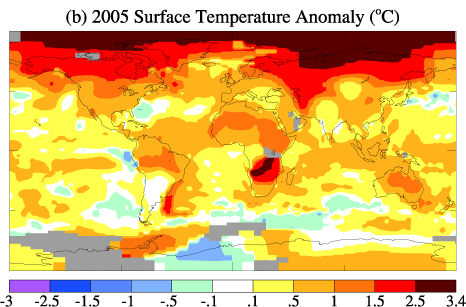(Part of the How to Talk to a Global Warming Skeptic guide)
Objection: The apparent rise of global average temperatures is actually an illusion due to the urbanization of land around weather stations, the Urban Heat Island effect.
Answer: Urban Heat Island Effect has been examined quite thoroughly (PDF) and found to have a negligible effect on temperature trends. Real Climate has a detailed discussion of this here. What’s more, NASA GISS takes explicit steps in their analysis to remove any such spurious signal by normalizing urban station data trends to the surrounding rural stations. It is a real phenomenon, but it is one climate scientists are well aware of and have taken any required steps to remove its influence from the raw data.
But heavy duty data analysis and statistical processing aside, a little common sense and a couple of pertinent images should put this idea to bed. Here is an image, taken from Astronomy Picture of the Day (a wonderful site, by the way), of the surface of the earth. It is a composite of hundreds of satellite images all taken at night. (The large version is well worth the download time!)

Aside from being very beautiful, it is a perfect indicator of urbanization on earth. As you can see, the greatest urbanization is over the continental United States, Europe, India, Japan, Eastern China, and generally coastal South America.
This next image was taken from NASA GISS. It is a global surface temperature anomaly map which shows warming (and infrequently, cooling) by region.

Look at North America, look at Europe, at Asia, Australia, Africa and the Poles and compare them to the urbanization in the image from APOD. There is quite simply no way to discern any correlation whatsoever between urbanization and warming. If the UHI effect were the cause of warming in the globally averaged record, we would see it in this map.
The claim that global warming is an artifact of the Urban Heat Island Effect is simply an artifact of the Urban Myth Effect.
Addendum: Wikipedia has a very good article on this subject. Among all the interesting details it mentions a few papers that directly discuss efforts to identify and quantify UHI influences on the global temperature trend including this one (PDF), which would be a good one to cite:
A 2003 paper (“Assessment of urban versus rural in situ surface temperatures in the contiguous United States: No difference found”; J climate; Peterson; 2003) indicates that the effects of the urban heat island may have been overstated, finding that “Contrary to generally accepted wisdom, no statistically significant impact of urbanization could be found in annual temperatures.” This was done by using satellite-based night-light detection of urban areas, and more thorough homogenisation of the time series (with corrections, for example, for the tendency of surrounding rural stations to be slightly higher, and thus cooler, than urban areas). As the paper says, if its conclusion is accepted, then it is necessary to “unravel the mystery of how a global temperature time series created partly from urban in situ stations could show no contamination from urban warming.” The main conclusion is that micro- and local-scale impacts dominate the meso-scale impact of the urban heat island: many sections of towns may be warmer than rural sites, but meteorological observations are likely to be made in park “cool islands.”
If necessary, be sure to refer to all the other ways we know the global warming trend is not an artifact of anything. It is real.
